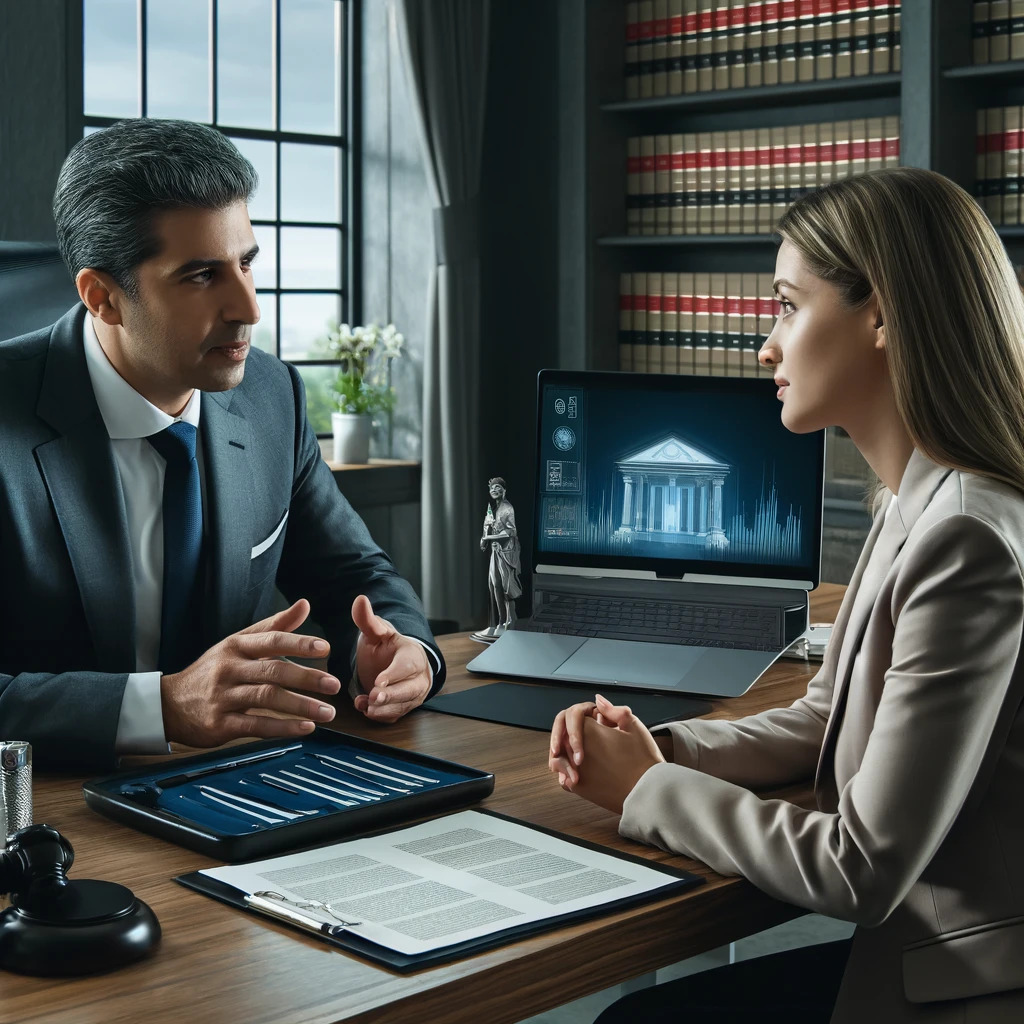Understanding Personal Injury Law
Personal injury law encompasses the legal remedies and defenses involved in civil lawsuits brought as a result of wrongful conduct. Essentially, when we talk about personal injury law, we’re focusing on the legal processes that come into play when someone suffers harm from an accident or injury, and another individual might be legally responsible.
Negligence is the cornerstone of most personal injury cases. It occurs when someone fails to take reasonable care, resulting in damage or harm to another person. Proving negligence is crucial for a successful personal injury claim; this involves demonstrating a duty of care, a breach of that duty, causation, and damages.
Liability refers to the legal responsibility for one’s actions or omissions. In the context of personal injury law, determining liability is key to understanding who is at fault and who must pay compensation. Personal injury lawyers play a pivotal role in establishing liability and negotiating settlements.
The statute of limitations is a critical concept in personal injury law. It sets the maximum time after an event within which legal proceedings may be initiated. Once this period expires, the claim may no longer be filed, making it imperative for injured parties to act promptly.
Comparative negligence is another important legal doctrine. In states with this rule, a damaged party can recover even if they are partially responsible, with the compensation amount reduced by their percentage of fault.
When pursuing a personal injury claim, documentation and evidence are key. We assist in compiling the necessary information to support the claim, such as medical records, witness statements, and expert testimony.
In summary, understanding personal injury law is fundamental for us as personal injury lawyers. Our expertise lies in navigating these legal principles effectively to secure equitable settlements for our clients.
The Settlement Negotiation Process
Negotiating a personal injury settlement is a nuanced process that involves multiple steps, each requiring legal expertise and experience. Our objective is to secure the most favorable outcome for the client, balancing the settlement value with the policy limits and insurance coverage.
Initiating the Negotiation
We begin by assembling a demand letter detailing the personal injury case, which includes evidence of damages, a summary of the injury, and the compensation amount we are seeking. This document is addressed to the insurance company or the insurance adjuster handling the claim. Its purpose is to outline the foundation for our settlement negotiations, and it serves as an official starting point for discussions.
Strategies for Effective Negotiating
Our approach to negotiating settlements is informed by both the specifics of the case and our broader experience. Key tactics include:
- Understanding the Insurance Policy: Knowledge of the policy limits and exclusions enables us to negotiate within realistic bounds while aiming for the maximum possible settlement.
- Effective Communication: Conveying the client’s position clearly and assertively to the insurance company helps us navigate the settlement process.
- Leveraging Evidence: In negotiations, we present evidence methodically to reinforce the strength of the claim.
Assessing Settlement Offers
When assessing an initial settlement offer, we critically evaluate its fairness against the client’s damages and suffering. Factors to consider include:
- Settlement Value: Judging the adequacy of the offer in relation to the injury’s impact on our client’s life.
- Counteroffers: If the initial offer falls short, we are prepared to make counteroffers that better reflect fair compensation.
- Tactical Patience: To optimize settlement terms, we don’t rush negotiations, understanding that patience can lead to better offers.
Concluding the Settlement
A settlement agreement concludes the negotiation process. In this final stage, we:
- Review the Settlement Agreement: Diligently examine the terms for accuracy and completeness.
- Advise on the Outcome: Discuss the settlement’s implications with our client, ensuring they understand all conditions.
- Finalize the Settlement: Once the agreement is accepted, we facilitate the paperwork to officially close the negotiation, leading to the disbursement of funds to our client.
Calculating Damages and Compensation
When we embark on negotiating a personal injury settlement, accurately calculating the monetary value of damages becomes crucial. This calculation ensures that the compensation reflects the extent of harm and suffering and aligns with the monetary boundaries defined by insurance policies. It’s our professional responsibility to scrutinize all facets of the incurred losses to secure just compensation for our clients.
Economic Damages
Economic damages represent the quantifiable financial losses resulting from an injury. These typically encompass:
- Medical Expenses: It includes past, current, and projected future medical bills for treatment related to the injury.
- Lost Wages: Money the injured party could not earn due to their inability to work.
- Damage to Property: Repair or replacement costs for any personal property harmed due to the incident.
Calculating these expenses is straightforward, as we can use bills and receipts as concrete evidence. However, calculating projected costs, such as future medical care or lost earning capacity, often requires expert testimony.
Non-Economic Damages
Non-economic damages are intangible and not so easily quantified. They include:
- Pain and Suffering: Compensates for physical discomfort and emotional stress.
- Loss of Enjoyment of Life: Money awarded for an inability to engage in hobbies or activities that were a source of joy before the injury.
While more complex to compute, they’re crucial in our pursuit of a comprehensive settlement. To estimate non-economic damages, we often rely on the multiplier method, which multiplies the economic damages by a number that reflects the severity of the pain and suffering experienced.
Special Considerations in Compensation
There are key legal nuances that we must take into account, such as:
- Insurance Policy Limits: Settlements may be constrained by the limits of the liable party’s insurance coverage.
- Collateral Source Rule: Some jurisdictions allow us to secure compensation for bills already paid by the plaintiff’s health insurance.
Negotiating a settlement is delicate, particularly when faced with staunch resistance from insurance companies looking to minimize payouts. Our approach is firm yet fair, ensuring that outcomes align with the lasting impact that injuries exert on our client’s life, both economically and emotionally.
Legal Documentation and Evidence
In personal injury lawsuits, the outcome often hinges on the strength and organization of legal documentation and evidence. We must meticulously prepare and present all relevant materials to negotiate effectively with insurance companies for fair injury settlements.
Gathering the Required Documentation
To formulate a claim, we gather all necessary documentation that emphatically supports the case. This includes:
- Medical Records: These comprehensive documents detail the extent of injuries, treatments undertaken, and the prognosis. They are often the cornerstone of the injury claim.
- Police Reports: If applicable, police reports provide an official account of the incident, which can be critical in establishing fault.
- Witness Statements: We seek out and compile all available witness accounts to reinforce the narrative of the case.
- Supporting Documents: Any additional documentation that can provide context or support to the claim, such as photographs of the incident scene or personal diaries documenting post-accident difficulties.
Strengthening Your Case through Evidence
The evidence we collect is pivotal in proving the claim and engaging with insurance companies. Elements of strong evidence include:
- Expert Testimony: We consult with medical experts to validate injury claims and prognoses.
- Legal Representation Reviews: These can include case analyses by ourselves as your personal injury lawyers, developing a persuasive argument that can lead to a successful negotiation.
- Quantitative Data: We compile expense reports, loss of income statements, and any other quantifiable losses suffered due to the injury.
A well-documented claim backed by solid evidence gives us leverage in settlement negotiations. Our approach assures that every piece of documentation and evidence aligns with the goal of obtaining the compensation deserved.
Alternative Dispute Resolution and Litigation
We understand that navigating through personal injury claims can be complex, involving numerous legal processes. Among these, alternative dispute resolution and litigation stand out as strategic ways to secure fair injury settlements.
Mediation and Arbitration
Mediation is a collaborative approach where a neutral third party, the mediator, facilitates communication between us and the insurance companies to reach a mutually agreeable settlement. This option is less formal than a trial and can often lead to quicker settlements, saving both time and legal expenses.
- Advantages of Mediation:
- Provides a confidential setting.
- Allows for creative and flexible solutions.
- Reduces acrimony between parties.
Arbitration, on the other hand, involves an arbitrator who hears evidence and arguments from both sides before making a legally binding decision. In personal injury law, arbitration can be a viable alternative when both parties want a definitive outcome without the public exposure of a trial.
- Advantages of Arbitration:
- Usually faster than litigation.
- Typically less costly than court trials.
- Arbitrator’s expertise in personal injury law can be beneficial.
When to Proceed to Trial
We decide to proceed to trial when settlement negotiations, including mediation and arbitration, fail to result in a satisfactory offer from the insurance company. During the trial, evidence is presented to a judge or jury in court, who then makes a decision on the compensation based on the legal system’s standards.
- Reasons to Go to Trial:
- The settlement offer is insufficient and does not cover all injury-related expenses.
- The insurance company denies liability.
- We are confident in our case and believe a jury will award a more fair compensation.
Although litigation is more time-consuming and expensive, it may be necessary to ensure that our clients receive the full extent of damages they are entitled to. Our legal expertise allows us to navigate the court procedures effectively, always aiming for the best possible outcome for our clients.
Frequently Asked Questions
In this section, we cover common inquiries about the intricacies of settlement negotiations in personal injury cases, providing clarity on tactics, fees, and the negotiation process.
How do lawyers negotiate settlements for personal injury cases?
Our negotiation process for personal injury settlements typically involves establishing a strong case by collecting evidence and calculating an appropriate compensation amount. We communicate the claim’s value to the insurance company or opposing counsel and adjust our strategy based on their responses and the unique aspects of the case.
What are examples of negotiation tactics used by personal injury lawyers?
As seasoned negotiators, we often employ tactics such as the ‘anchoring’ strategy, where we set a high initial demand to anchor the negotiations favorably. We also use the ‘bracketing’ method, countering offers with our own range, which gradually narrows to find common ground.
What percentage of a settlement is typically expected as a lawyer’s fee?
The common fee structure for personal injury lawyers is a contingency fee, which is usually about one-third of the settlement amount. However, this can vary based on the case complexity, legal market, and fee agreements established prior to taking the case.
How can personal injury lawyers reduce medical bills during settlement negotiations?
We actively work to reduce medical bills by negotiating with healthcare providers to lower the costs or by asserting health insurance, med-pay benefits, or statutory reductions. This typically involves discussing with medical providers to prevent overcharging and ensuring clients’ settlements aren’t unduly diminished by excessive bills.
What steps are involved in negotiating an out-of-court settlement for a personal injury claim?
Negotiating an out-of-court settlement involves several key steps: we first gather all necessary evidence and documentation, then determine the case value. Next, we send a demand letter stating our terms. Upon receiving a counteroffer, we engage in a series of negotiations to reach a potential settlement that reflects our clients’ best interests.
What factors influence the duration of settlement negotiations in personal injury cases?
The length of settlement negotiations in personal injury cases hinges on factors like case complexity, the extent of injuries, the clarity of liability, the amount of monetary damages involved, and the insurance company’s willingness to settle. Patient negotiations might take longer but can result in better compensation for clients.




